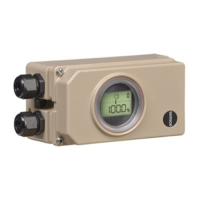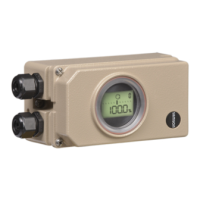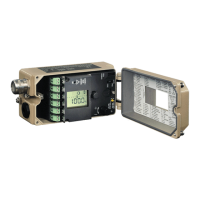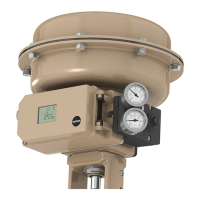EB 8384-3 EN 3-3
Design and principle of operation
Inductive limit switch
In this version, the rotary shaft of the posi-
tioner carries an adjustable tag which actu-
ates the built-in proximity switch. The option-
al inductive switch (11) is connected to A1,
while the remaining software limit switch is
connected to A2.
External position sensor
In this version, only the sensor is mounted to
the control valve. The positioner is located
separately from the valve. The connection of
x and y signals to the valve is established by
cable and piping for air (only without induc-
tive limit switch).
Analog input x
The analog input x option allows commer-
cially available external linear or angle posi-
tionsensorsthatusea4to20mAsignalto
be connected to the positioner. The analog
input x is protected against reverse polarity
andoverloadupto24VAC/DC.Theposi-
tioner switches to open-loop operation (no
closed-loop operation) as soon as the input
signalfallsbelow2.5mA.
Leakage sensor
By upgrading the positioner with a leakage
sensor, it is possible to detect seat leakage
when the valve is in the closed position.
Binary input
Positionerscanbeoptionallyttedwithabi-
nary input. The following actions can be trig-
gered by changing the edge state:
− Transmit switching state [default]
The switching state of the binary input is
logged.
− Set on-site operation write protection
Whilethebinaryinputisactive,noset-
tings can be changed at the positioner.
EnablingcongurationoverCode3is
not active.
− Switch between AUTO/MAN
The positioner changes from the auto-
matic mode (AUTO) to the manual
mode (MAN) or vice versa.
This function is not performed if the posi-
tioner is in the fail-safe position mode
(SAFE).
− VariousdiagnosticfunctionsuEB8389
(EXPERTplus valve diagnostics)
− The optional binary input can only be con-
gured using the TROVIS-VIEW software
and using the DD parameters (u8389 on
EXPERTplus valve diagnostics).
− The default switching state is with an open
switch.
3.3 Communication
The positioner is equipped with an interface
for HART
®
protocol (Highway Addressable
Remote Transducer) for communication pur-
poses. Data are transmitted in a superim-
posedfrequency(FSK=FrequencyShiftKey-
ing) on the existing signal loop for the 4 to
20mAsetpoint.
Note
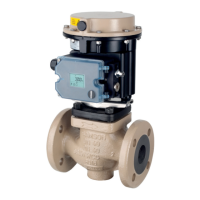
